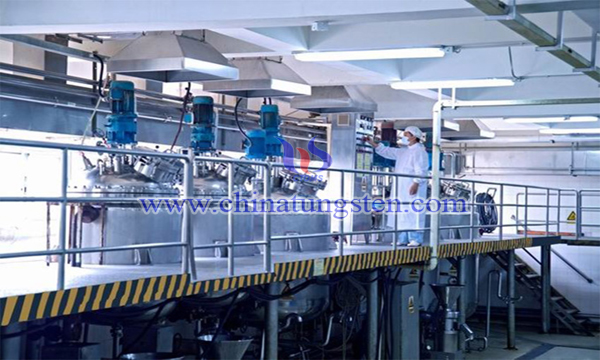Ammonium Paratungstate Production by Guanidine Salt Separation Method
- Details
- Category: Tungsten Information
- Published on Monday, 30 July 2018 10:57
At present, there are two methods for the production of ammonium paratungstate. First, the industrial sodium tungstate solution is first made to make white tungsten, then the concentrated acid is made into tungstate under the condition of heating and cooking. Then tungstate is made into ammonium paratungstate. The industrial sodium tungstate solution through anion exchange resin and then rinse with concentrated ammonium chloride, so that tungsten is made into ammonium tungstate. Then, the tungsten is made into ammonium tungstate. It is evaporated into ammonium paratungstate. Both of two methods have no molybdenum removal. To achieve the purpose of removing molybdenum, or to reduce the crystallization rate of ammonium paratungstate to 70-80%, the mother liquid should be removed from molybdenum after reducing the crystallization rate.

Guanidine salt separation method, including the following steps: using the industrial ammonium tungstate solution after the removal of silicon as the starting material, using silica (SiO2) or silicic acid as the catalyst, heating aging under the condition of pH = 7.0-8.0, filtering off the catalyst, adding guanidine or guanidine derivatives as precipitant, making tungsten (W) formed guanidine precipitate and precipitation rate. More than 98%, while molybdenum (Mo) remained in the filtrate, the removal rate of molybdenum was more than 95%. Sedimentation and filtration are washed with cold water for several times, and precipitates are used for the production of ammonium paratungstate or sodium tungstate products.
AR 330g (Na2MO4 •2H2O) and sodium molybdate (Na2Wo4 •2H2O) 0.747g(W: Mo weight ratio is 987: 1), dissolved in 1 liters of hot water, artificially obtained sodium tungstate solution with impurity molybdenum, adding 5g of silica catalyst, heated and stirred with 10% hydrochloric acid 250ml, reflux for 4 hours, filtrate and precipitant two benzidine 185g, adding 10% hydrochloric acid to pH 7.5 in the continuous stirring condition, stirring for half an hour, and precipitating parotungstate two benzidine, filtrating and washing water several times, retained for preparation of ammonium paratungstate and sodium tungstate. The precipitation rate is 98.5%, the tungsten content in the filtrate (WO3) is less than 1.5g/ liter. The W: Mo in the sediment is 33000: 1, the removal rate of molybdenum is 97%.
The precipitates were added to 400ml 1: 1 ammonia water, stirring for half an hour, filtration, washing, and insoluble substances being two benzidine, which could be reused, the filtrate was evaporated and concentrated at 80 ~100°C, and filtered, ammonium paratungstate crystal was obtained. Filtration, washing again and 210g of ammonium paratungstate. The tungsten in the filtrate is then returned to the fresh ammonium tungstate solution and evaporated again.
The most significant advantage of the guanidine salt separation method is that it can remove the impurity molybdenum effectively while producing ammonium paratungstate and sodium tungstate, abolishing the traditional sulphide molybdenum removal process and eliminating the hydrogen sulfide pollution. In addition, the primary crystallization rate of ammonium paratungstate and sodium tungstate can be increased by nearly 20% compared with the traditional production process.
- APT Manufacturer & Supplier, Chinatungsten Online: ammonium-paratungstate.com
- Tungsten News & Prices of China Tungsten Industry Association: www.ctia.com.cn
- Molybdenum News & Price: news.molybdenum.com.cn
- Tel.: 86 592 5129696; Fax: 86 592 5129797; Email: sales@chinatungsten.com



 sales@chinatungsten.com
sales@chinatungsten.com